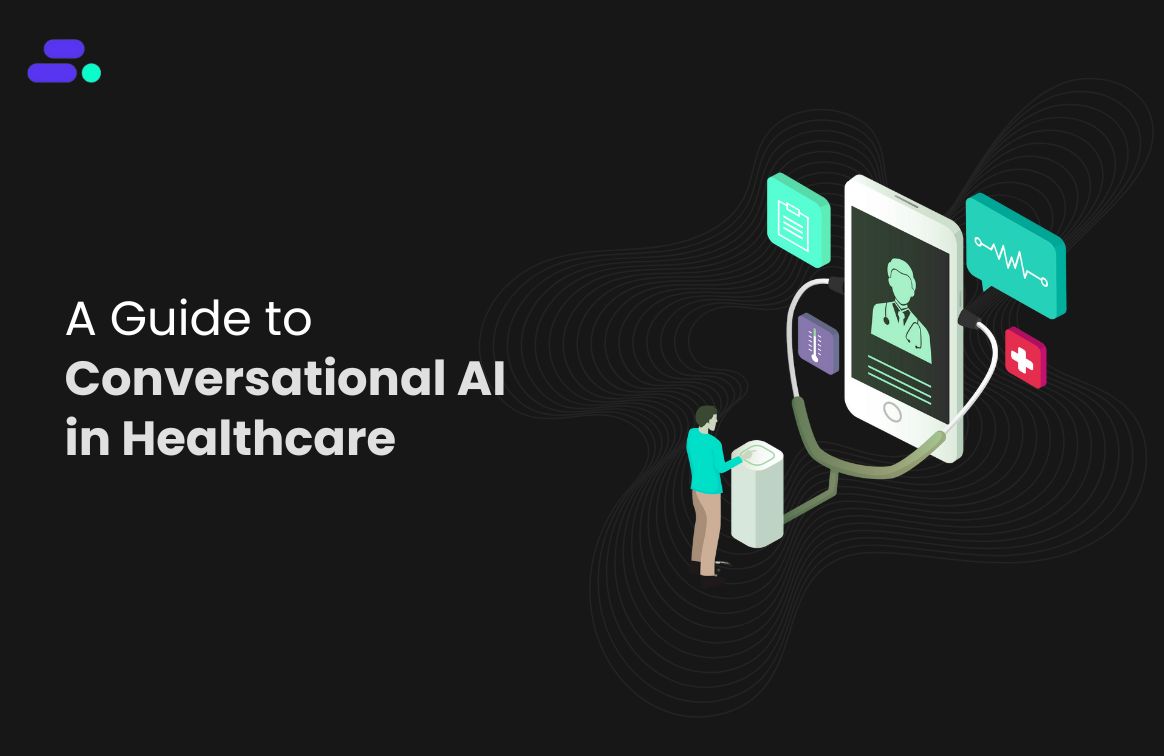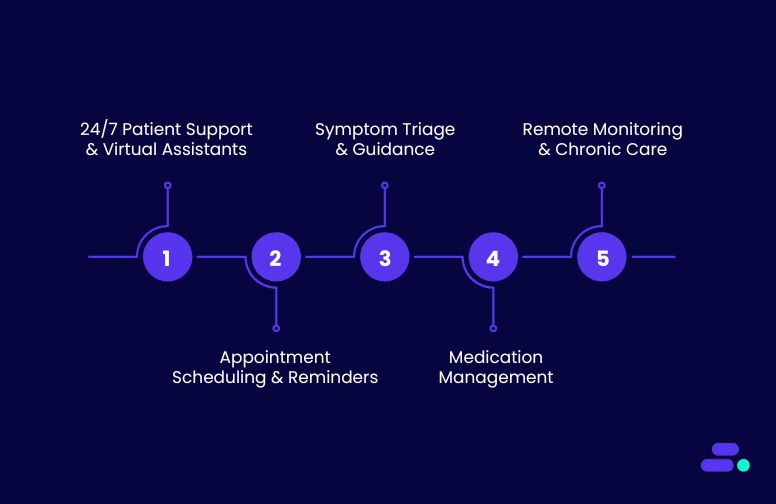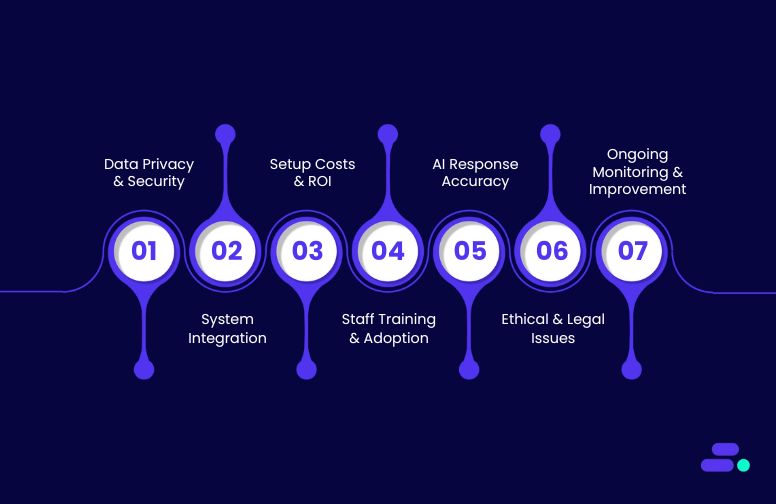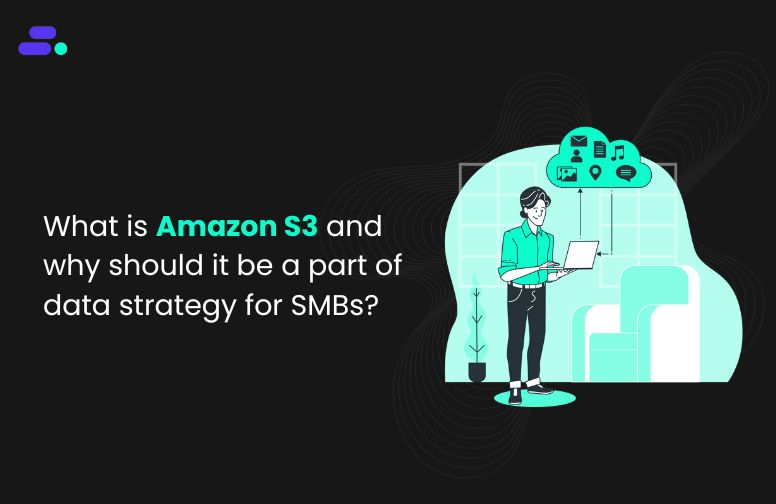This is a div block with a Webflow interaction that will be triggered when the heading is in the view.

Modernize your cloud. Maximize business impact.
Healthcare organizations today are under immense pressure to deliver better patient outcomes, comply with strict regulations, and manage growing volumes of sensitive data while controlling costs. Cloud computing offers a transformative solution, enabling healthcare businesses to store and process data securely, scale operations efficiently, and access advanced analytics and artificial intelligence tools that drive smarter decision-making.
This guide explores the key benefits of cloud computing in healthcare and how it can enhance patient care, operational efficiency, and data security.
Key takeaways:
- Cloud computing in healthcare helps improve data access, scalability, and collaboration while enabling secure, patient-centered operations.
- Key benefits include cost efficiency, improved data management, enhanced security, and faster innovation through cloud-based technologies.
- Healthcare SMBs can utilize cloud computing in 10 impactful ways, enhancing patient care, streamlining operations, and improving compliance.
- Common challenges like compliance, data migration, and integration can be overcome with structured strategies and AWS-native tools.
- Cloudtech helps healthcare SMBs modernize with AWS, enabling secure data foundations, resilient workloads, and AI-ready environments.
How can cloud computing improve healthcare? Key benefits
Cloud computing offers a modern approach to improving healthcare by centralizing data, enabling secure access, and providing advanced analytics and AI capabilities. Implementing the cloud enables healthcare providers to streamline operations, enhance collaboration, and deliver smarter, faster, and more personalized care.

Here are some of the benefits of cloud computing in healthcare:
- Enhanced patient care: Cloud-enabled access to patient records and real-time data allows healthcare providers to make faster, more informed decisions, improving diagnosis and treatment outcomes.
- Improved data security and compliance: Cloud platforms offer advanced security controls, encryption, and compliance tools to protect sensitive patient data and meet regulatory requirements like HIPAA.
- Operational efficiency: Automating administrative tasks, streamlining workflows, and centralizing data in the cloud reduces operational bottlenecks and lowers costs.
- Scalability and flexibility: Cloud infrastructure can quickly scale to handle growing patient data, telehealth demands, or new applications without major upfront investments.
- Data-driven insights: Advanced analytics, AI, and machine learning tools in the cloud help identify trends, predict outcomes, and enable personalized care.
- Collaboration and accessibility: Secure cloud access allows doctors, nurses, and staff to collaborate across locations, improving care coordination and patient engagement.
Adopting cloud computing empowers healthcare businesses to stay agile, secure, and patient-focused. It provides a foundation for innovation, better decision-making, and sustainable growth in the healthcare sector.
Suggested Read: Best practices for AWS resiliency: Building reliable clouds

10 ways SMBs can utilize cloud computing in healthcare
For small and medium healthcare businesses, cloud computing is no longer a future consideration, but an essential part of delivering better patient care, managing costs, and maintaining compliance. Adopting cloud-based solutions allows healthcare SMBs to centralize medical data, enable remote access for doctors and patients, and use AI-driven insights to make smarter clinical and operational decisions.
The result is a secure, scalable foundation that supports innovation without the heavy overhead of traditional IT infrastructure:
1. Modernize electronic health records (EHRs)
Cloud-based EHR systems simplify patient data management, giving providers instant access to records from any device. This improves care coordination, reduces duplication, and enhances patient safety.
How it helps:
- Centralizes patient information across multiple departments and clinics.
- Enables real-time data access for faster, more coordinated care.
- Reduces manual record handling and compliance risks.
Outcome: Providers gain a complete view of patient history, improve diagnostic accuracy, and deliver more efficient, connected care.
2. Enable telehealth and remote care
With cloud-powered platforms, healthcare SMBs can deliver secure teleconsultations and remote monitoring. This expands access to care while ensuring data remains encrypted and compliant.
How it helps:
- Hosts telehealth platforms and patient apps with secure data exchange.
- Integrates remote device data for continuous health tracking.
- Scales easily to manage fluctuating patient volumes.
Outcome: Healthcare providers can extend their reach, improve accessibility, and maintain continuity of care regardless of location.
3. Improve data security and compliance
Leading cloud providers offer built-in security controls like encryption, access management, and auditing. This helps SMBs meet strict regulations such as HIPAA or GDPR without maintaining complex local systems.
How it helps:
- Implements encryption, access control, and auditing automatically.
- Reduces exposure to breaches through automated threat detection.
- Simplifies adherence to HIPAA, GDPR, and local privacy standards.
Outcome: Healthcare SMBs strengthen patient trust, reduce compliance complexity, and operate with consistent data security.
4. Streamline administrative operations
From appointment scheduling to billing and claims management, cloud automation eliminates manual processes. It reduces paperwork, improves staff productivity, and cuts operational costs.
How it helps:
- Automates workflows and reduces manual data entry.
- Provides centralized dashboards for financial and patient data.
- Integrates easily with third-party healthcare management tools.
Outcome: Administrative tasks take less time, staff productivity improves, and operating costs decrease.
5. Support clinical research and data analysis
Cloud-based analytics allow healthcare teams to analyze structured and unstructured data, like lab results or physician notes, to identify trends, improve treatments, and accelerate research outcomes.
How it helps:
- Consolidates clinical data from multiple systems into one view.
- Enables data mining and predictive analytics for better research insights.
- Accelerates trials and reporting with automated pipelines.
Outcome: Healthcare SMBs can make data-driven decisions faster, supporting innovation and evidence-based patient care.
6. Build disaster recovery and business continuity
Cloud backup and recovery solutions safeguard patient data from system failures, cyberattacks, or natural disasters. This ensures minimal downtime and uninterrupted care delivery.
How it helps:
- Enables automated data backups across secure locations.
- Reduces recovery time through managed replication and failover.
- Ensures operations continue during outages or cyber incidents.
Outcome: Organizations minimize downtime, protect patient trust, and maintain service delivery under all conditions.
7. Enable interoperability and data sharing
Healthcare SMBs can securely exchange information across hospitals, labs, and insurance systems. Cloud APIs and integration tools ensure that patient data stays consistent and accessible across systems.
How it helps:
- Connects clinics, labs, and insurance systems through secure APIs.
- Maintains standardized, interoperable data formats.
- Enhances visibility into patient journeys across providers.
Outcome: Data moves securely between systems, reducing duplication and enabling coordinated, informed care.
8. Use AI for smarter diagnostics
Cloud-based AI models can process imaging data, detect anomalies, and assist doctors in early diagnosis. This improves accuracy and reduces time spent on manual analysis.
How it helps:
- Processes imaging and diagnostic data in real time.
- Identifies patterns and anomalies with precision.
- Reduces the time required for manual review.
Outcome: Healthcare teams deliver faster, more accurate diagnoses and improve patient outcomes with AI-driven insights.
9. Enhance patient engagement
Patient portals hosted in the cloud give individuals access to their health records, prescriptions, and care plans. This transparency fosters trust and encourages patients to take an active role in their health.
How it helps:
- Provides access to health records, prescriptions, and lab results.
- Enables secure communication between patients and providers.
- Supports reminders, follow-ups, and wellness programs.
Outcome: Patients stay informed and involved, leading to better adherence, satisfaction, and health outcomes.
10. Scale services with demand
As healthcare needs grow, cloud infrastructure allows SMBs to scale quickly—whether adding storage, supporting new applications, or expanding to new locations—without major upfront costs.
How it helps:
- Scales automatically to meet patient and data growth.
- Adapts to new care models or digital services quickly.
- Offers predictable, usage-based pricing.
Outcome: Organizations expand seamlessly, stay agile, and invest only in the capacity they truly need.
The cloud provides the flexibility and intelligence that today’s healthcare organizations need to grow sustainably and serve patients better.
Also Read: AWS cost optimization strategies and best practices

Solving the biggest cloud challenges in healthcare SMB modernization
Adopting cloud computing offers healthcare SMBs major advantages, but the path to transformation isn’t always straightforward. Many smaller providers face challenges like maintaining compliance, integrating legacy systems, managing costs, and ensuring uptime, all while working with limited technical expertise.
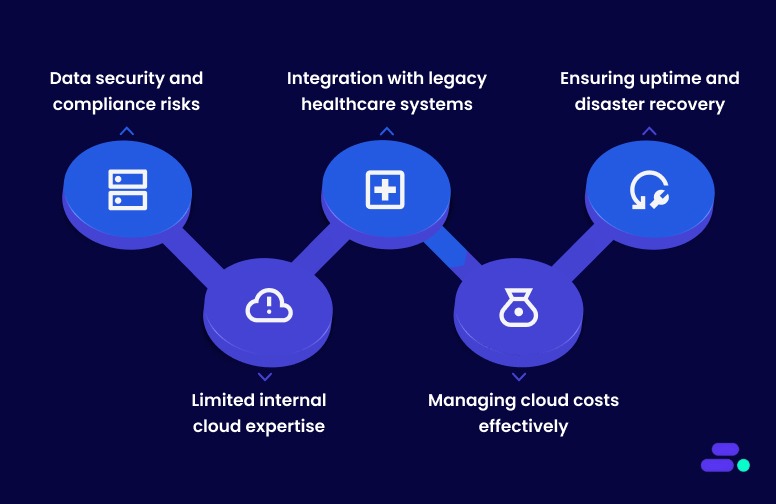
Addressing these barriers early helps healthcare organizations build secure, scalable, and cost-efficient cloud environments that truly enhance patient care and business continuity.
Here are some common challenges and their solutions for cloud computing in healthcare:
1. Data security and compliance risks: Handling patient data requires adherence to strict standards like HIPAA and GDPR. Many healthcare SMBs struggle to balance innovation with compliance, fearing breaches or audit failures.
Solution: Adopt AWS HIPAA-eligible services and enable built-in encryption for data in transit and at rest. Use AWS Identity and Access Management (IAM), AWS CloudTrail, and AWS Audit Manager to ensure visibility, traceability, and compliance reporting.
2. Limited internal cloud expertise: Healthcare SMBs often lack the in-house talent to architect, secure, and optimize complex AWS environments. This leads to inefficiencies, poor configurations, and unnecessary costs.
Solution: Engage an AWS-Certified Solutions Architect on-demand for expert reviews, environment optimization, and knowledge transfer. Partnering with AWS Advanced Tier Partners like Cloudtech ensures architecture decisions follow the AWS Well-Architected Framework.
3. Integration with legacy healthcare systems: Legacy EHRs, billing, and lab systems often use outdated protocols, making cloud integration difficult and prone to data silos.
Solution: Use AWS HealthLake and secure APIs for interoperability. Implement phased modernization, starting with lightweight integrations before migrating full systems, to ensure continuity and minimize disruption.
4. Managing cloud costs effectively: Without proper oversight, cloud expenses can rise unpredictably, especially when workloads scale or data storage grows rapidly.
Solution: Use AWS Cost Explorer and AWS Budgets for ongoing visibility and alerts. Implement lifecycle policies in Amazon S3 and rightsizing recommendations from AWS Trusted Advisor. Cloudtech also provides cost optimization reviews tailored for SMB budgets.
5. Ensuring uptime and disaster recovery: Healthcare operations depend on always-available systems. Downtime can disrupt patient services, impact care delivery, and result in compliance violations.
Solution: Adopt AWS multi-AZ deployment strategies and enable automated backups through AWS Backup or Amazon RDS snapshots. Implement disaster recovery workflows with cross-region replication and regular failover testing.
With AWS best practices and expert guidance from an Advanced Tier AWS Partner like Cloudtech, these organizations can confidently overcome limitations, modernize securely, and build a cloud foundation that supports long-term innovation.
Also Read: Common security pitfalls during cloud migration, and how to avoid them

How Cloudtech helps healthcare SMBs implement cloud computing
For healthcare SMBs, adopting cloud computing can seem complex, especially when balancing patient data security, compliance, and system uptime. Cloudtech simplifies this transition through an AWS-based, healthcare-aware approach designed for long-term reliability, efficiency, and compliance with regulations such as HIPAA.
Here’s how Cloudtech enables healthcare-ready cloud transformation:
- Cloud foundation and compliance governance: Establishes secure AWS multi-account environments using AWS Control Tower, AWS Organizations, and AWS IAM, ensuring healthcare data governance, access control, and cost visibility from the start.
- Workload migration and resiliency: Migrates clinical and administrative systems using AWS Application Migration Service, AWS Backup, and Amazon Route 53, enabling low-downtime transitions and built-in disaster recovery for continuous care delivery.
- Application modernization for clinical systems: Re-architects legacy healthcare applications into scalable, serverless solutions with AWS Lambda, Amazon ECS, and Amazon EventBridge, enhancing interoperability, scalability, and operational efficiency.
- Data modernization and interoperability: Uses Amazon S3, AWS Glue, and Amazon Redshift to unify patient and operational data pipelines, supporting secure, real-time analytics, faster insights, and integrated care delivery.
- AI-powered healthcare innovation: Applies Amazon Q Business, Amazon Bedrock, and AWS data services to enable use cases such as intelligent document processing, predictive insights, and conversational analytics across healthcare workflows.
Cloudtech’s structured AWS migration methodology ensures that healthcare SMBs don’t just move to the cloud. They modernize securely, optimize performance, and enable continuous innovation to improve patient outcomes.
See how other SMBs have modernized, scaled, and thrived with Cloudtech’s support →

Conclusion
Cloud computing has become an important tool in healthcare, offering a range of benefits such as operational efficiency, improved patient care, and cost savings. By enhancing data accessibility, enabling real-time collaboration, and supporting advanced analytics, cloud technology is transforming healthcare delivery across the globe. Healthcare providers who adopt cloud solutions are better positioned to streamline operations, ensure compliance, and improve patient outcomes.
Cloudtech’s services, including Data Modernization, Infrastructure and Resilience, are designed to support your healthcare organization's evolving needs. Optimize your operations and ensure your data and infrastructure are secure and scalable for the future. Reach out to Cloudtech!
FAQs
1. How does cloud computing improve patient care?
A: Cloud computing enhances patient care by providing healthcare professionals with immediate access to accurate and up-to-date patient data, regardless of location. It also supports telemedicine, remote monitoring, and personalized treatment plans, improving patient outcomes and reducing care delays.
2. Can cloud computing help healthcare organizations stay compliant with regulations?
A: Yes, cloud computing helps healthcare organizations comply with regulations like HIPAA by providing secure data storage and enabling real-time monitoring of patient information access. Cloud solutions are continuously updated to comply with industry regulations and security standards.
3. How can cloud computing help my healthcare organization save on operational costs?
A: Cloud computing can significantly reduce the need for expensive on-site infrastructure, such as physical servers and storage systems. By shifting to the cloud, your healthcare organization can cut hardware costs, maintenance expenses, and IT staff overhead while benefiting from scalable solutions that grow with your business needs.
4. Is cloud computing suitable for small and medium-sized healthcare businesses?
A: Absolutely! Cloud solutions are flexible and scalable, making them ideal for businesses of all sizes. As a small or medium-sized healthcare provider, cloud computing allows you to access enterprise-level technology without the significant upfront costs or complex management. This allows you to compete with larger organizations while optimizing your operations.
5. How can cloud computing support my business's disaster recovery and backup plans?
A: Cloud solutions offer comprehensive backup and disaster recovery options, ensuring your data is safe and can be easily recovered during an emergency. By utilizing cloud infrastructure, you can maintain business continuity during natural disasters or technical issues, ensuring minimal downtime and data loss.

Get started on your cloud modernization journey today!
Let Cloudtech build a modern AWS infrastructure that’s right for your business.
